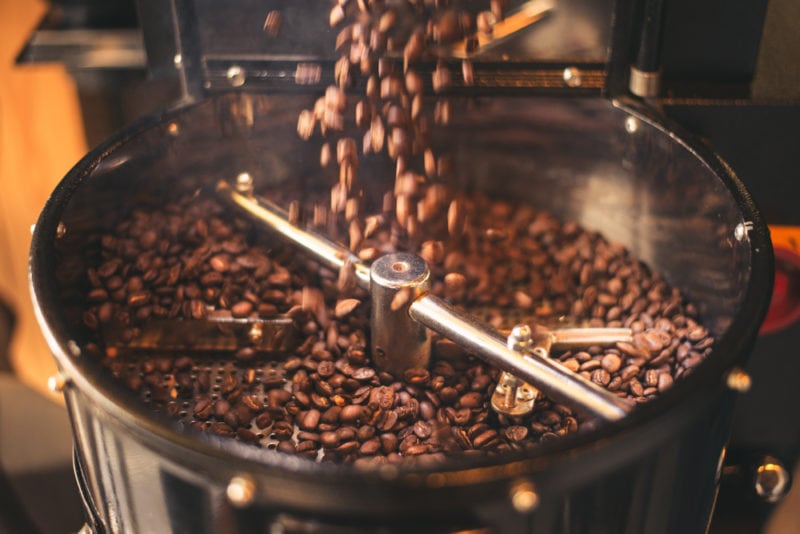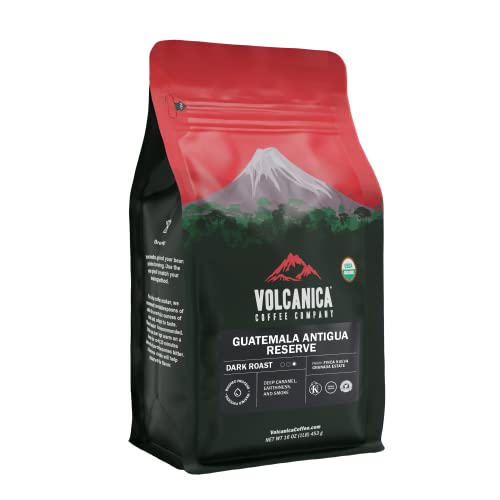Interested in learning about where most of your delicious coffee comes from? It’s most likely from Guatemala.
One of the most influential coffee growers and exporters in the world, Guatemala is a gold-mine for coffee farmers. Its warm, wet, high elevation climate is ideal for creating some of the best coffee beans you can buy.
At a Glance: Our Top 5 Picks for Guatemalan Coffee
Quick Summary: The Best Guatemalan Coffee
 | Our Top Choice PORTLAND COFFEE ROASTERS GUATEMALA |
| Check Price → |
 | GUATEMALA ANTIGUA |
| Check on Amazon → |
 | PANTHER COFFEE FINCA EL LIMONAR |
| Check Price → |
 | GUATEMALA PEABERRY |
| Check on Amazon → |
 | JAVA PLANET GUATEMALA HUEHUETENANGO COFFEE |
| Check on Amazon → |
 | DAM GOOD COFFEE–GUATEMALAN DARK ROAST |
| Check on Amazon → |
 | GUATEMALA SAN MARCOS COFFEE |
| Check on Amazon → |
 | GUATEMALA CUBICO ANTIGUA COFFEE |
| Check on Amazon → |
In The Beginning…
Coffee was introduced to the Guatemalan landscape in the mid-1700s by Jesuit missionaries. The plants were originally used for ornamentation until they began being utilized in the mid-late 1800s. Farmers began utilizing their coffee harvesting after the collapse of Guatemala’s natural color-dyeing industry, which occurred after the increasing usage of synthetic dyes.
This utilization occurred as a result of the government’s searching to create a new economy to support the country. With the support and assistance of the establishment of coffee plantations, the industry began to take off. From the late 1800s to 2011, Guatemala was ranked as one of the world’s top 5 coffee producers and exporters in the world.
Nowadays, Guatemala has an estimated 130,000 farmers planting, harvesting, and exporting coffee beans throughout the country.
Flavor Overview
Guatemalan coffee is generally known for being strong, moderate in acidity, full-bodied, and filled with delicious flavor. The secret behind this great flavor isn’t necessarily about the plants themselves, but more so the environment where they’re grown.
The higher the elevation that coffee is grown, the more robust and flavorful it is. Higher altitudes possess more necessities that coffee plants need to not only grow but thrive. Around 5,000 feet, there’s more access to sunshine, stable temperatures, and moderate rainfall. For Guatemala, several regions fit this description perfectly.
However, there are other factors besides elevation that influence the quality of Guatemalan (and any) coffee. Things like soil quality, rainfall amount, exposure to sunlight, and cultivation methods all affect the roasting and overall flavor of the coffee beans.
Best Guatemalan Coffee Brands
Interested in getting your hands on some of the most delicious beans Guatemala has to offer? We’ve collected a list of some of the most vibrant blends on the market right now.
Portland Coffee Roasters Guatemala

Portland Coffee Roasters Guatemala
Tons of chocolaty sweetness cools nicely to a gentle fruity finish.
The beans Portland Coffee Roasters sources for this blend hail from Guatemala, but of course, you knew that; the coffee is simply named “Guatemala” and you’re reading about the best Guatemalan coffees. But if you want to talk about specific locations (and when we’re talking coffee, you always do!), these beans come from Miguelina Villatoro’s Finca El Paternal, with whom the brand has conducted business for nearly 20 years.
Maintaining such a long-lasting business relationship usually means that whatever’s being produced is worthwhile, and this bag of light roast coffee is no exception. The delicious brew is sweet and smooth, littered with notes of chocolate, raisin, cinnamon, and molasses — a perfect choice for leisurely sipping while you’re curled up on a cozy couch.
Volcanica Coffee: Guatemala Antigua
Grown in the volcanic areas of Guatemala, Volcanica specializes growing and harvesting coffee grown in some of the highest elevation points in Antigua. These beans are a tasty sample of some of the best roasts that Guatemala has to offer.
This medium roast is vibrant in acidity and has delicious notes of chocolate and nuts, and is a full-bodied roast that is deep and creamy. For those who like a strong, bold cup of coffee, this roast will create a sweet, chocolatey aroma that will leave you wanting more.
Panther Coffee Finca El Limonar

Panther Coffee Finca El Limonar
A round, chocolaty sweetness complements this cup’s bright splash of cherry acidity and notes of roasted almond.
With a mission statement like that of Panther Coffee — “to source, roast, and prepare the finest coffees in the world,” according to the company’s website — you know you’re getting quality beans. That’s why we feel pretty good about recommending the brand’s Guatemalan brew, Finca El Limonar.
The beans are named after the award-winning farm on which they’re grown, and once they make their way to Panther’s roasting location in Miami, they are medium roasted before being shipped to you and your at-home brewer. Your cup of Finca El Limonar will be sweet and creamy with notes of milk chocolate and fresh black plum — that sounds pretty good to us!
Volcanica Coffee: Guatemala Peaberry
A heavily-bodied brew with smokey overtones, Volcanica’s Guatemala Peaberry blend is smooth and robust in flavor. This blend is set apart from others not only because of the influence of rich volcanic soil but also because of the actual peaberries themselves.
Peaberries are coffee cherries that are divergent of regular cherries. Normally, a coffee cherry consists of two beans in a pod that both receive nutrients from the plant. However, there is only one bean that develops, and that one bean will collect, store and extract the number of nutrients needed for two beans from the plant. This extra boost of flavor is why many treat peaberries like coffee gold.
Java Planet Guatemala Huehuetenango Coffee
This organic blend by Java Planet packs a powerful flavor and is easy on the acidity. Filled with the flavor of caramel and fruit, the beans are succulent and sweet. This medium roast is ideal for anyone who’s looking for a refreshing, savory cup of joe to enjoy.
Java Planet is certified with Fair Trade, SMBC Bird Friendly, and is 100% chemical and pesticide-free. So not only are their coffee beans roasted with flavor quality in mind, but the quality behind the company is great as well.
Dam Good Coffee–Guatemalan Dark Roast
Not only does this organic dark roast blend support a good cause, but it tastes “dam” good as well. Dam Good Coffee is a family-owned company, donating a portion of all profits to support welfare work in Africa.
Collected in small batches, roasted to perfection, and filled with robust, dark flavor, these beans are a strong pick-me-up for those who enjoy a bold and tasty cup of coffee. Packaged and sealed in air-tight bags, every bag is kept fresh and ready to brew.
Two Volcanoes Coffee: Guatemala San Marcos Coffee
Two Volcanoes Coffee produces coffee that is robust, deep in flavor, with an oriental twist to it. Grown in the San Marcos region, this coffee is grown next to two volcanoes, just as the name describes. The nutrient-rich area creates beans that are ripe, healthy, with the right amount of oils and sugars needed to make a perfect Guatemalan roast.
This is a medium blend, harboring floral and nutty undertones with a sweetness that’s light and mild. Low on acidity, this blend is perfect for those who need something full of flavor, but sensitive on the stomach too. It’s full-bodied and silky-smooth, making each sip more enjoyable than the last.
Cubico Coffee: Guatemala Antigua Coffee
Cubico’s bright blend of fruity flavors is intense enough to cure any coffee craving. It’s light and tangy in acidity, highlighted with notes of orange, lemon, and milk chocolate. Collecting their beans from Antigua, Cubico’s blend is fresh, revitalizing, and delightful to sip on.
In addition to its light aftertaste, it’s also velvety and full-bodied. The farmers at Cubico roasts their beans in small batches, and sign the date of roasting on them to ensure freshness. Not only will this blend guarantee you a delicious cup of coffee, but a clean, fresh brew as well.
Growing Regions of Guatemalan Coffee
The Americas produces some of the greatest, and the largest amount of high-quality coffee in the world. Primarily growing Arabica beans, Guatemala has some of the most delicious beans in Central America due to its large tropical climate, lengthy wet season, and high elevation.
Different coffee-regions in Guatemala include Antigua, Acatenango, Atitlán, Cobán, Huehuetenango, Fraijanes Plateau, San Marcos, and Nuevo Oriente. Antigua is perhaps the best-known coffee growing region in Guatemala. Each of these regions has microclimates that support the growth of coffee beans. Here’s a quick breakdown of each.
Antigua
Since it’s surrounded by three volcanoes and covered in rich volcanic soil, Antigua is perhaps one of the most well-known coffee-growing areas in Guatemala. Located in the central-southern region of the country, this area is low in humidity, receives lots of sunlight, and has cool evening temperatures. All of these things make the perfect conditions to grow delicious coffee.
Acatenango Valley
Coffee in Acatenango Valley is grown under dense shady areas that are located near the steep slopes of Fuego Volcano. This valley is located closeby, slightly southwest of Antigua. Eruptions from this volcano keep the soil full of nutrients and minerals that help the coffee crops grow strong and healthy.
Atitlán
Another volcanic region, this area in southwestern Guatemala is an excellent environment for growing coffee due to it’s rich, organic soil covering the volcanic slopes surrounding Lake Atitlán. This is a warm, moist, nutrient-abundant atmosphere that supports the growth of many coffee farms.
Cobán
Receiving a gentle rainfall of about 3,300-4,000mm of rain for 8-10 months of the year, Cobán is one of the most fertile regions in Guatemala. This constant rainfall means that the flowering of the coffee crops prolonged. To harvest the ripest cherries, they have to be sorted through up to about 10 times to select the best beans available, making for an extra-refined roasting of beans.
Huehuetenango
Located in the western region of Guatemala, Huehuetenango is located in one of the three non-volcanic regions in the country. Its atmosphere is one of the highest and driest coffee growing regions, keeping it safe from frost all year long. The abundance of rivers and streams keep the soil saturated and sufficient for growing coffee.
Fraijanes Plateau
With high altitudes and heavy rainfall, the Fraijanes Plateau is located near another volcanic region, Pacaya. This moderately sprinkles the soil with volcanic ash to enrich it with the extra minerals and vitamins needed to help the coffee plants thrive.
San Marcos
The San Marcos area is the warmest of these regions in Guatemala, and also has the highest amount of rainfall in the area. As a result, the flowering is earliest here due to the early arrival of seasonal rains. Most of the coffee is pre-dried in the sun and then later dried in other machines as a result of the unpredictability of the rainy season.
Nuevo Oriente
Since the 1950s, coffee has been cultivated in the Nuevo Oriente exclusively by small-town, local farmers. Located near a former volcanic range, the environment is often rainy and cloudy, making a dense, moist atmosphere that’s ideal for coffee cultivating. The soil embodies a large amount of metamorphic rock, providing coffee crops with an abundance of nutrients.
Factors That Affect Coffee Growth
Each savory cup of coffee begins with a dedication to planting, nurturing, growing, harvesting, and roasting. However, this process requires several conditions to be completed.
Elevation
Coffee grown at higher elevations tend to be higher in quality and more vibrant in flavor. This is because at higher altitudes there are harsher growing conditions like harsher winds, colder temperatures, heavier rainfall, and more exposure to sunlight.
All of these factors make it more difficult for coffee plants to grow. However, this is beneficial for developing the flavor of the beans because the cooler atmosphere slows down the growth of the coffee plant. Because of the slow growth rate, the plant is forced to focus more on bean production, creating more of the sugars that give coffee its delicious flavor.
Guatemala is successful in cultivating coffee because many locations are high in elevation, making the perfect conditions in which to grow the plants.
Soil Quality
Another factor of coffee production is the quality of the soil in which the plants are grown. Coffee can be planted in a variety of soils, but the best soils are ones that allow water to be drained easily to and from the plant’s roots. This is why hard or clay soil is the best.
However, the best of the best of soils is volcanic soil. The soil must have all of the important elements needed to nurture the coffee trees, like phosphorus, potassium, calcium, nitrogen, boron, and zinc. Since volcanic soil is packed with all of these helpful nutrients and more, coffee plants that are grown here can thrive and flourish.
Rainfall
Just as water supports every other living thing on our planet, water is also very important when it comes to supporting coffee crops. Rainfall of about 1,500-2,000 millimeters (60-80 inches) is needed from 8-10 months during the year to support healthy, flourishing crops.
All of the Guatemalan regions listed above have adequate rainfall to support the growth of these plants. Growing the plants at a higher elevation also helps the plants receive adequate rainfall because cooler air doesn’t hold as much moisture as warmer air does.
Sunlight
Coffee plants require bright, but indirect sunlight for about 2 hours a day. In higher altitudes, this checkered lighting method is ideal for plants who are at a higher altitude. However, plants at a lower altitude need more exposure to sunlight to efficiently complete the process of photosynthesis.
Processing Methods
Guatemala has a very wet, humid climate, so most of the processing of coffee is achieved through the wet process.
Coffee processing occurs after the coffee cherries have been collected. Once all the coffee is harvested, it must be cleaned and the inside beans removed so the roasting process can begin. Though there are many different processes for coffee, the wet process is most efficient for Guatemalan coffee since there’s a surplus of moisture in the atmosphere already.
The wet process, also known as “washed coffee,” produces the highest quality coffee because it involves the fermentation of coffee beans over about 1-2 days, sometimes longer. The cherries are pulped by a machine and removed from their mucilage, and then fermented to release the oils and sugars needed to give the coffee its flavor.
How To Brew
As delicious as Guatemalan coffee is, it’s also highly versatile when it comes to brewing. Whether you enjoy hot coffee, drip coffee, pour-over coffee, or cold brew, there are many options for brewing Guatemalan coffee for every coffee lover.
French Press
Since Guatemalan coffee is packed full of flavor, one of the best brewing methods to highlight this flavor is the French Press. Using the process of immersion, the French Press is perfect for brewing Guatemalan coffee. Due to the constant contact of the hot water with the coffee grounds, the flavors within the coffee beans are evenly extracted.
Pour Over
The pour-over method is also very beneficial in bringing out the delicious flavors in Guatemalan roasts. Like the French press, the pour-over also produces a rich, full-bodied cup of coffee. By continuously pouring hot water over the medium-fine/medium-coarse grinds, the grounds are evenly saturated and can “bloom” as water filters through them.
Drip Coffee
One of the most popular brewing methods in American homes today, drip coffee is a quick and simple way to brew Guatemalan coffee. Since many electric brewers can pour hot water evenly over the grounds, it makes for a steady, even extraction of coffee.
Cold Brew
You can make a scrumptious and refreshing cold-brew through using the drip method or immersion method of cold brewing. Brewing Guatemalan coffee with the cold brew method highlights the lighter acidity and sweetness in the beans.
Wrapping Up
A prominent force in the coffee industry, Guatemala has a significant influence on South American coffee production. Though it’s not the most prominent in the world, the quality of Guatemalan coffee exceeds the quantity.
However, Guatemalan coffee should be on any coffee lover’s list of coffees to try. Each sip is worth your while and is sure to become a quick favorite for any coffee connoisseur.
Happy caffeinating!














